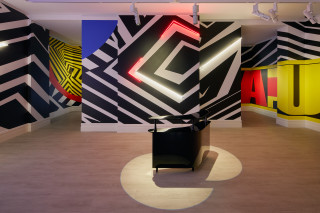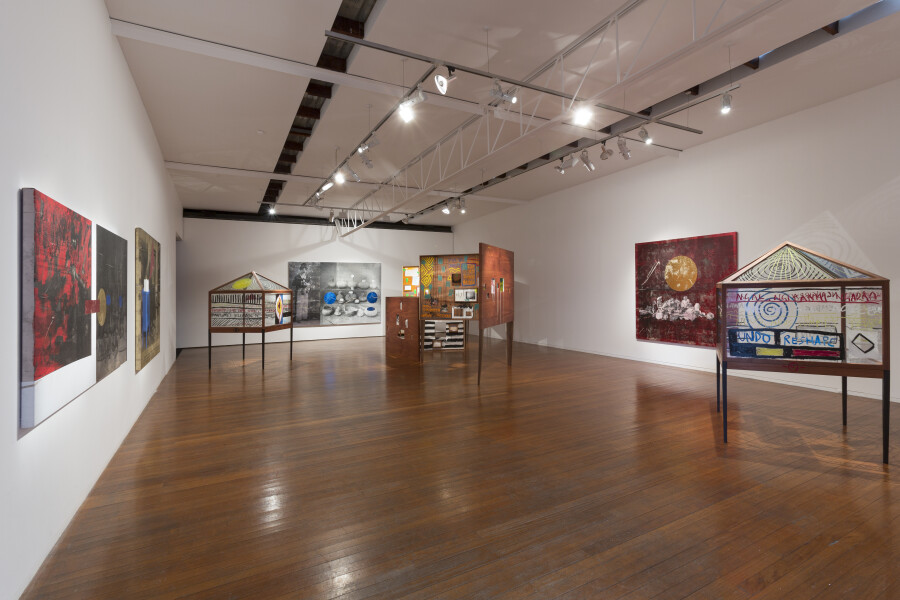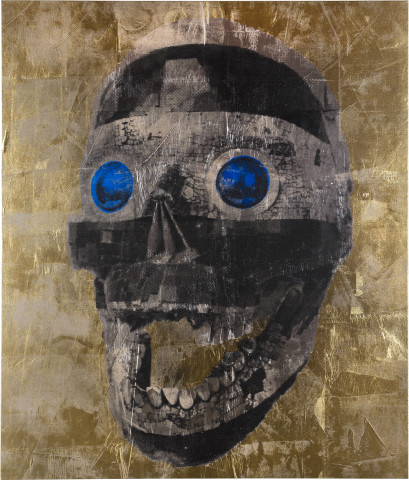Alternate narratives are fed to us through smashing together multiple discourses sourced from the Internet, television, newspapers to museums, our education systems and Andrew’s extensive archive collection.
Exhibition Dates: 8 March – 7 April 2018
Roslyn Oxley9 Gallery is pleased to present SMASH IT, featuring multidisciplinary works by Brook Andrew, created through meticulous processes of archival research. In SMASH IT, a title also referring to his video work in the exhibition, the artist presents a mix of video, neon, mixed-media painting and sculptural installation. Together the works question the perceptions of history and identity, and the narratives associated with primitivism and colonialism. This exhibition coincides with the artist’s participation in the 21st Biennale of Sydney, SUPERPOSITION: Equilibrium & Engagement, curated by Mami Kataoka. Brook Andrew’s presentation will be featured at the Museum of Contemporary Art Australia, Sydney on March 16 – June 11, 2018.
SMASH IT is a reference to the actions of the artist’s ability to interweave, reveal, research and disrupt the regular dominant narratives of our lives with both humour and serious questioning. These alternate narratives are fed to us through smashing together multiple discourses sourced from the Internet, television, newspapers to museums, our education systems and Andrew’s extensive archive collection. The artist has continuously discovered new ways to present alternative narratives often left in the dark, or unpopular due to complex layering of colonial or other drifting discourses.
In SMASH IT, Andrew is compelled to literally smash together found archive material from the Smithsonian Institute, Washington, DC, and his own private collections, new video interviews with intellectuals and creatives such as Marcia Langton and Wesley Enoch, media from the Internet and snippets from cinema. In this way of mixed-media intervention, applying his own method of re-configuring new narratives that upturns ideological beliefs and struggles, exploding and smashing often taboo questions around protocols and international themes, he demonstrates the web of humanity that we are all caught within. In this way, his video SMASH IT (2018) is a kind of palimpsest with an iconoclastic action. This palimpsest reveals multiple layers of identities and events, past and present, destructions and creation of objects, and the revealing and introduction of new methods of thinking about the issues he raises. Similar to Andrew’s curatorial projects such as ‘TABOO’ at the Museum of Contemporary Art Australia, Sydney, he brings together many voices to speak out from the dark.
As Andrew’s Mirror (2017) sculptures reveal, in their Sapelli timber (a European colonial forested timber from Africa, still used today) and ancient Australian red-gum from the Murray river, is a reminder of both architectural dividers and traditional teaching black-boards. The artist’s choice of materials, such as timber, plays a heavy hand in revealing vast time diversions, archaeology and space. The energy of mixed languages and archives spraying across its surface, his hand in full motion, the energy compulsive and addictive, invites us to mingle and see the mess, but also asks us to re-connect the dots. He provides exciting challenges to dare shift historical legacies such as the work ‘primitivism’ itself, as in the words ‘KILL PRIMITIVISM’ in both the Mirror sculpture and the blazing red neon. In many ways, to NGAAY is to also revisit our own inherited ‘blind spots’. As disparate and challenging some material is such as the U.S.A. KKK newspaper archive, to social events in Redfern and press-photo of the Supremes, Andrew’s aim is to bring about an exploded wunderkammer of activity and human interaction with the world around us: Actions in unison with his scrawled prose on one of his sculptures ‘the totem explodes with vigour’!
His recent Smithsonian Artist Research Fellowship has inspired the 2D works, mixing the archives of the Smithsonian with his own private collection. His deep research on Frontier Wars in both Australia and reflecting on the U.S.A. colonial experience in his current ARC (Australia Council Research) project, has opened new ground concerning, for example, the depiction of human remains alongside ceramics in ethnographic photographs in Clown with Gifts (2018). The action of the Frontier Wars in Australia, the U.S.A., Canada and other nations, also includes the bizarre display of cultural objects alongside human remains and also the complexity of how these objects are now distributed internationally. Clown with Gifts exemplifies the juxtaposition of the artists’ personal collection with images from the Smithsonian’s photographic archive. The clown is rigid and still like the ceramics, an awkward gesture in nod to a stern ceremonial presentation of ancient ceramics. Somehow this duel/dual awkwardness is complimentary by the strange juxtaposition of culture on display. The circles that cover certain objects in the 2D works and also in the video SMASH IT refer to a protocol process Andrew has been involved in for many years. The covering, in this case, of human skulls that were photographed alongside the ceramics. Other works like Robot II (2018) is a reference to how skulls entered the public realm and outside of ceremonial or other public events into the world of curiosity.
Beach II (2018), Office II (2018) and Fuselage (white body) (2018) are from Andrew’s personal archive. These images are painted and collaged to reference the speed and technology, and simultaneous destruction of our planet and resources, but with also extreme benefit and advancement. His use of covering aspects of the image with either paint or covering faces is again an action to bring attention to identities and histories that are often mislead, interrupted or misunderstood. The work Head (silver), (2018) relies on the mix of archival material from a residency as a Photography Residencies Laureate at the Musée du quai Branly, Paris, and his own photo archive. The gaze of the camera clearly offers us to re-consider the doctrines behind the plaster cast, the Neanderthal in global ethnography, and how we have been deemed to sit within the international human hierarchy of civilisation. The hierarchy of civilisation is revisited again and again in Andrew’s artworks. His main aim is to capture our imagination, to challenge hidden meanings in objects and media. His research into the Frontier Wars and other international legacies connect Australia, drawing it to an epi-centre that does not escape the connections of international slavery history, regardless if it is historical or contemporary. In many ways, Andrew asks us to controversially ponder the complex term ‘slavery’ in our own views of how we read history through dominant narratives and our own inheritance.
Andrew worked very closely with collection managers, First Nation advisors and anthropologists at the Smithsonian to resolve a way to present images that are often difficult for descendants to view. This conversation is similar to those he has established with people such as Maxine Briggs (interviewed in SMASH IT) from the State Library of Victoria, Australia. The Wiradjuri word NGAAY appears in the video work, meaning to ‘see’. This word is an invitation by the artist to literally ‘see’ differently. An invitation to open up and reconsider the world we are currently enmeshed within. The artist prods us further to question how it could be imagined differently if we smashed the usual narratives to reveal the shards of new views and possible beginnings. The artist is not inviting us to destroy cultural materials, or indeed our own convictions, but instead proposes a shift deep inside of us all.
SMASH IT will be Brook Andrew’s second solo exhibition at Roslyn Oxley9 Gallery, Sydney.
—
Brook Andrew most recently curated an installation 'Ahy-kon-uh-klas-tik', an interrogation of the Van Abbemuseum archives and art collection in Holland, which re-imagines a different world timeline. In 2017 he also created 'Room A' a curatorial and art intervention into the collection of the Musée d'ethnographie de Genève, Switzerland; ‘The Right to Offend is Sacred’ opened at the National Gallery of Victoria, Melbourne, a 25-year reflection on his practice; included in the National Indigenous Art Triennial: Defying Empire at the National Gallery of Australia, Canberra. In 2016 as a Photography Residencies Laureate at the musée du quai Branly, Paris, Andrew created the series The Resident and The Visitor which investigated the relationship between the colonial photographer and the sitter. Additionally, with his collaborator Trent Walter, the public artwork Standing By Tunnerminnerwait and Maulboyheener was installed adjacent Melbourne Gaol. This is Australia’s first official government supported memorial to the frontier wars.
Andrew’s current research includes an ambitious international comparative three-year Federal Government Australian Research Council grant for 2016-2018, titled Representation, Remembrance and the Memorial. The project is designed to respond to the repeated high-level calls for a national memorial to Aboriginal loss and the frontier wars. Across October and November 2017, Andrew completed a Smithsonian Artist Research Fellowship, with the Smithsonian Institute, U.S.A.; and in 2018 to present What’s Left Behind, a new commission for SUPERPOSITION: Art of Equilibrium and Engagement at the 21st Biennale of Sydney, of which he invited four creatives to exhibit in his sculptures.
Brook Andrew has been exhibiting internationally since 2000 and represented Australia in the Echigo-Tsumari Triennale in Japan (2012). Andrew has exhibited in solo and group exhibitions at major institutions including Tate Britain, London; Museo Nacional Centro de Arte, Reina Sofia, Madrid; Museum of Contemporary Art, Yinchuan, Sydney and Seoul; Künstlerhaus, Vienna; Jewish Museum, Berlin; Australian Centre for Contemporary Art, Melbourne; Queensland Art Gallery | Gallery of Modern Art, Brisbane; Teylers Museum, Haarlem, Netherlands; Museum Dr Guislain, Ghent, Belgium; Art Gallery of New South Wales, Sydney; Museum of Old and New Art, Hobart; National Gallery of Victoria, Melbourne. Andrew has worked with archival collections from significant museums including Museo de América, Madrid; Museo Nacional de Antropología, Madrid; Musée d’Aquitaine, Bordeaux; Royal Anthropological Institute, London; Museum of Archaeology and Anthropology, Cambridge; Pitt Rivers Museum, Oxford; and the Anthropology Department of the University of Vienna, Austria.

ink, acrylic paint, linen
202 x 300 x 5 cm; three canvases - 202 x 95 x 5cm; 111 x 205 x 5cm; 91 x 205 x 5cm

Sapele timber, paint, block board, paper, perspex and glue
dimensions variable
 Group Show, The First 40 Years
Group Show, The First 40 Years
Roslyn Oxley9 Gallery, 2024
 Group Show, The National 4
Group Show, The National 4
Museum of Contemporary Art, Sydney and Campbelltown Arts Centre, 2023
 Thinking Historically in the Present
Thinking Historically in the Present
Sharjah Biennial 15, 2023
 Brook Andrew GABAN: House of Strange
Brook Andrew GABAN: House of Strange
Roslyn Oxley9 Gallery, 2022
 Brook Andrew DIWIL
Brook Andrew DIWIL
Murray Art Museum Albury, 2021, 2021
 Brook Andrew This Year
Brook Andrew This Year
Roslyn Oxley9 Gallery, 2020
 Brook Andrew Horizon Line II
Brook Andrew Horizon Line II
Musée du quai Branly — Jacques Chirac, 2020
 Brook Andrew The Space Between
Brook Andrew The Space Between
, 2018-19
 Brook Andrew What's Left Behind
Brook Andrew What's Left Behind
21st Biennale of Sydney, 2018
 Brook Andrew SMASH IT
Brook Andrew SMASH IT
Roslyn Oxley9 Gallery, 2018
 Brook Andrew AHY-KON-UH-KLAS-TIK
Brook Andrew AHY-KON-UH-KLAS-TIK
Van Abbemuseum, The Netherlands, 2017
 Brook Andrew A Working Model of The World
Brook Andrew A Working Model of The World
University of New South Wales Galleries, Sydney, 2017
 Brook Andrew The Right to Offend is Sacred
Brook Andrew The Right to Offend is Sacred
National Gallery of Victoria, Melbourne, 2017
 Brook Andrew Space & Time
Brook Andrew Space & Time
Roslyn Oxley9 Gallery, 2016
 Group Show, Really Useful Knowledge
Group Show, Really Useful Knowledge
Museo Nacional Centro de Arte Reina Sofía, Madrid, 2015
 Brook Andrew Sanctuary: Tombs of the Outcasts
Brook Andrew Sanctuary: Tombs of the Outcasts
Ian Potter Museum, Melbourne, 2015
 Brook Andrew Evidence
Brook Andrew Evidence
Museum of Applied Arts and Sciences (MAAS), Sydney, 2015-16
 Brook Andrew Intervening Time
Brook Andrew Intervening Time
Asia Pacific Triennial of Contemporary Art, 2015
 Brook Andrew Horizon I
Brook Andrew Horizon I
Royal Melbourne Institute of Technology Design Hub, Melbourne, 2015


























